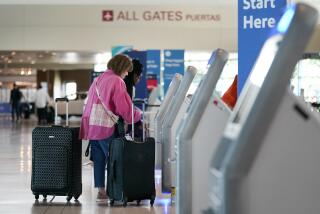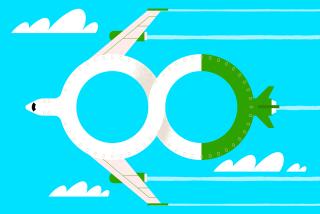Airport kiosks do nearly everything but check luggage
The growing army of self-serve kiosk computers at the nation’s airports never sleeps, never complains and works fast. And today the machines are being asked to do more than ever.
Responding to the growing frustration with airport lines, America’s major airlines have added thousands of self-serve kiosks in the last few years so passengers can print boarding passes, confirm flights and change seats on the touch-screen computers.
At Los Angeles International Airport, the newest kiosks also print luggage tags, provide airport maps and let passengers buy seat upgrades and make hotel reservations.
US Airways, Alaska Airlines and other carriers have recently installed kiosks on the curb outside terminals so passengers can print boarding passes and bypass the crowds inside. Some of the computers are weather-resistant.
The most advanced airport kiosks can even let passengers get on a plane without ever printing a boarding pass, said Owen Wild, a vice president for NCR Corp., the largest manufacturer of airline kiosks.
These new kiosks send a digital message to a passenger’s cellphone. The passenger can open an attachment to the phone message and let the Transportation Security Administration screener or airline attendant scan the bar code that appears on the screen.
Currently, airlines that use self-serve kiosks can serve an average of 55 passengers per hour per agent, compared with only 21 without the kiosks, according to industry studies.
In the future, kiosks may let passengers buy a meal on the plane or volunteer to give up a seat if a flight is overbooked, said Valerie Wunder, a spokeswoman for US Airways. “We are looking to enhance what the customer can do at the kiosk,” she said.
The trend has taken off.
In 2003, NCR Corp. operated about 2,000 kiosks in 120 airports in North America. By 2005, the company had installed about 4,800 kiosks at 285 airports. Today NCR has more than 8,400 kiosks at more than 300 airports worldwide.
Airline representatives say they have not reduced the number of human attendants to make way for the kiosks.
“Our goal is to make the process faster with the current staffing that we have and give passengers a little more freedom,” said Billy Sanez, an American Airlines spokesman.
One of the only things the kiosks can’t do is check a bag. An airline agent must still stick a tag on the luggage and make sure it is under the airline’s weight limit.
Not everyone likes the new technology.
Industry studies show that self-serve kiosks are increasingly popular with younger passengers who feel at ease using high-tech gadgets. But older travelers who are uncomfortable using computers and hand-held devices prefer to talk to humans.
“For Grandma, who comes into town once a year, she wants someone to help her get through the gate,” said Jeff Butler, Alaska Airlines’ vice president of customer services.
Business travel is looking up
The hotel and airline industries, which rely heavily on first-class business travelers who stay in high-end hotels, have been stung by the dramatic drop in business travel over the last year.
But the trend may be starting to reverse.
A survey by the U.S. Travel Assn., a travel trade group, and Ypartnership, a marketing and advertising firm, found that 18% of regular travelers expected to take at least one business trip between last October and April 2010, up from 17% for the same period a year earlier.
The survey of 2,244 travelers, conducted in early October, also found that business travelers planned to make an average of 4.8 trips that month, up from 3.3 trips last April.
The National Business Travel Assn. issued its annual cost forecast recently that also suggested good news for travelers in the future.
The forecast predicted that average prices for hotel rooms, airline tickets and rental cars would continue to drop in 2010. Nearly 70% of travel managers responding to an association survey said they expected their travel budgets to grow in 2010 and overall business travel to increase.
But business travelers shouldn’t expect to return to the free-spending days of the past.
Craig Banikowski, the trade group’s president, expects travel managers to perform more audits of travel spending, put tighter restrictions on “premium class” travel and increasingly push to get each trip to result in more profit.
In short, business travelers will have to keep bypassing business-class seats and four-star accommodations and booking coach tickets and economy hotels.
Fly to India for $40? Not so fast
Be careful next time you see an airfare that sounds too good to be true. It may be just that.
British Airways and the U.S. Department of Transportation announced last week that the airline would pay cancellation penalties and other expenses for customers who bought a $40 ticket that the carrier erroneously offered for flights from the United States to India.
The lowest British Airways prices for flights to India are more than $750, not including taxes.
The $40 rate was posted on British Airways’ website on the evening of Oct. 2. Within minutes, the airline realized the mistake and pulled the offer from the site. But nothing dies easily on the Internet.
For the next two hours, the deal remained on the websites of several online travel agents. The airline got more than 1,200 bookings for the $40 fare during that time, representing 2,200 passengers.
The airline canceled the reservations and has offered each passenger a $300 travel voucher. The airline will also consider reimbursing passengers who canceled other travel plans to take advantage of the deal.
How did this error happen?
John Lampl, a British Airways spokesman, said the airline was planning to announce a $40 increase in fares on flights from the U.S. to India. But an employee who was typing in the website information left out a crucial word in the announcement: “increase.”
“It was a typo,” Lampl said. “It was a human error.”
Customers who expected to pay $40 for a flight to India should have guessed that the offer was a mistake, he said: “Anyone with any travel sense had to have known that something was wrong.”
More to Read
Inside the business of entertainment
The Wide Shot brings you news, analysis and insights on everything from streaming wars to production — and what it all means for the future.
You may occasionally receive promotional content from the Los Angeles Times.










